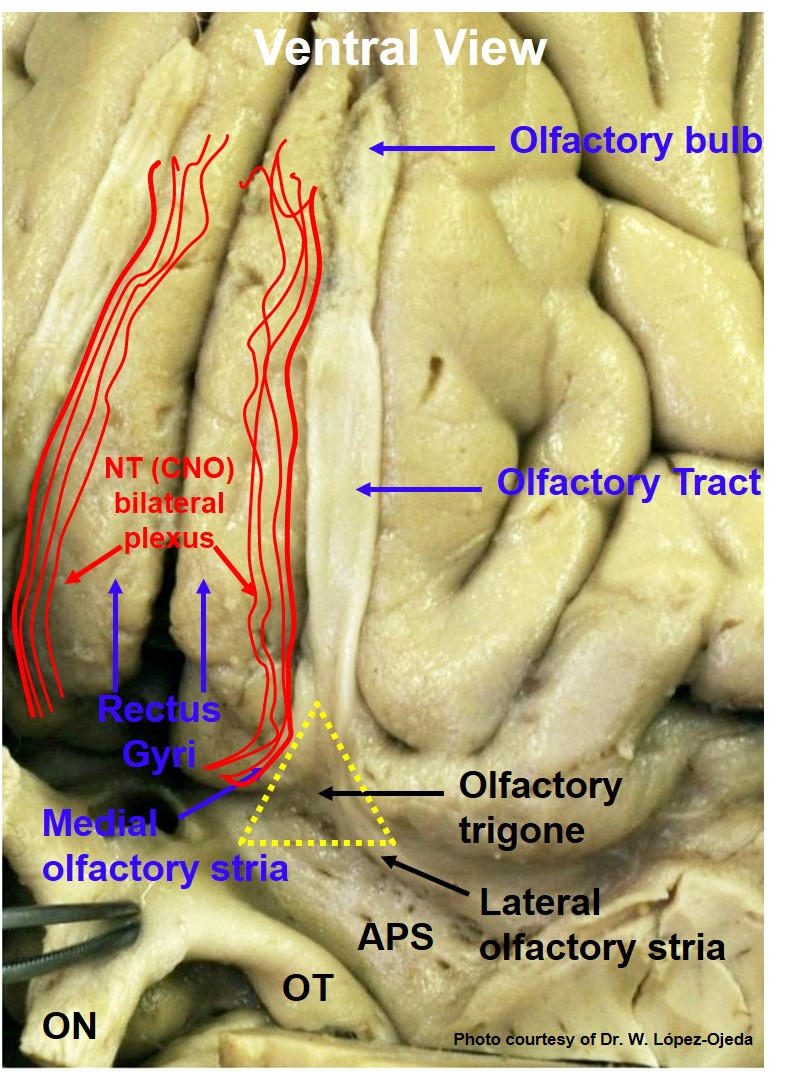[1]
The neglected cranial nerve: nervus terminalis (cranial nerve N)., Vilensky JA,, Clinical anatomy (New York, N.Y.), 2014 Jan
[PubMed PMID: 22836597]
[2]
Developmental Origins of Hypothalamic Cells Controlling Reproduction., Biehl MJ,Raetzman LT,, Seminars in reproductive medicine, 2017 Mar
[PubMed PMID: 28278530]
[3]
Response to "The neglected cranial nerve: nervus terminalis (cranial nerve N)"., Winkelmann A,, Clinical anatomy (New York, N.Y.), 2014 Sep
[PubMed PMID: 24659085]
[4]
Nervus terminalis (cranial nerve zero) in the adult human., Fuller GN,Burger PC,, Clinical neuropathology, 1990 Nov-Dec
[PubMed PMID: 2286018]
[5]
The terminal nerve plays a prominent role in GnRH-1 neuronal migration independent from proper olfactory and vomeronasal connections to the olfactory bulbs., Taroc EZM,Prasad A,Lin JM,Forni PE,, Biology open, 2017 Oct 15
[PubMed PMID: 28970231]
[6]
The terminal nerve (nervus terminalis): structure, function, and evolution.,, Annals of the New York Academy of Sciences, 1987
[PubMed PMID: 3448965]
[7]
The terminal nerve (nervus terminalis): structure, function, and evolution. Introduction., Demski LS,Schwanzel-Fukuda M,, Annals of the New York Academy of Sciences, 1987
[PubMed PMID: 3448964]
[9]
Computer ranking of the sequence of appearance of 73 features of the brain and related structures in staged human embryos during the sixth week of development., O'Rahilly R,Müller F,Hutchins GM,Moore GW,, The American journal of anatomy, 1987 Sep
[PubMed PMID: 3661464]
[10]
Development of olfactory and related structures in staged human embryos., Bossy J,, Anatomy and embryology, 1980
[PubMed PMID: 7469043]
[11]
Development of the nervus terminalis in mammals including toothed whales and humans., Oelschläger HA,Buhl EH,Dann JF,, Annals of the New York Academy of Sciences, 1987
[PubMed PMID: 3448969]
[12]
The nervus terminalis in insectivorous bat embryos and notes on its presence during human ontogeny., Brown JW,, Annals of the New York Academy of Sciences, 1987
[PubMed PMID: 3448966]
[13]
Gonadotropin-releasing hormone (GnRH) cells arise from cranial neural crest and adenohypophyseal regions of the neural plate in the zebrafish, Danio rerio., Whitlock KE,Wolf CD,Boyce ML,, Developmental biology, 2003 May 1
[PubMed PMID: 12710963]
[14]
Development of the nervus terminalis: origin and migration., Whitlock KE,, Microscopy research and technique, 2004 Sep
[PubMed PMID: 15570589]
[16]
LHRH-immunoreactive neurons in the pterygopalatine ganglia of voles: a component of the nervus terminalis?, Wirsig-Wiechmann CR,Lepri JJ,, Brain research, 1991 Dec 24
[PubMed PMID: 1814573]
[17]
The terminal nerve: a new chemosensory system in vertebrates?, Demski LS,Northcutt RG,, Science (New York, N.Y.), 1983 Apr 22
[PubMed PMID: 6836287]
[19]
Neuroanatomy of the kisspeptin signaling system in mammals: comparative and developmental aspects., Lehman MN,Hileman SM,Goodman RL,, Advances in experimental medicine and biology, 2013
[PubMed PMID: 23550001]
Level 2 (mid-level) evidence
[20]
The neuroanatomy of the kisspeptin system in the mammalian brain., Mikkelsen JD,Simonneaux V,, Peptides, 2009 Jan
[PubMed PMID: 18840491]
[21]
[The role of the vomeronasal system in the formation of the human sexual behaviour]., Morozova SV,Savvateeva DM,Svistushkin VM,Toporkova LA,, Vestnik otorinolaringologii, 2017
[PubMed PMID: 28514374]
[22]
Roles of sex and gonadal steroids in mammalian pheromonal communication., Baum MJ,Bakker J,, Frontiers in neuroendocrinology, 2013 Oct
[PubMed PMID: 23872334]
[23]
The prairie vole vomeronasal organ is a target for gonadotropin-releasing hormone., Wirsig-Wiechmann CR,Wiechmann AF,, Chemical senses, 2001 Nov
[PubMed PMID: 11705805]
[24]
Steroidal pheromones and their potential target sites in the vomeronasal organ., Andrea R,Daniel M,Gebhart MV,Jirikowski GF,, Steroids, 2017 Sep 26
[PubMed PMID: 28962851]
[25]
Revisiting the Vomeronasal System From an Integrated Perspective., Salazar I,Barrios AW,SáNchez-Quinteiro P,, Anatomical record (Hoboken, N.J. : 2007), 2016 Nov
[PubMed PMID: 27594382]
Level 3 (low-level) evidence
[26]
Fate and Development of Human Vomeronasal Organ - A Microscopic Fetal Study., Vasuki AK,Fenn TK,Devi MN,Hebzibah TD,Jamuna M,Sundaram KK,, Journal of clinical and diagnostic research : JCDR, 2016 Mar
[PubMed PMID: 27134849]
[27]
The vomeronasal organ - incidence in a Bulgarian population., Stoyanov G,Moneva K,Sapundzhiev N,Tonchev AB,, The Journal of laryngology and otology, 2016 Apr
[PubMed PMID: 26831012]
[28]
Swee DS,Quinton R,Maggi R, Recent advances in understanding and managing Kallmann syndrome. Faculty reviews. 2021;
[PubMed PMID: 34046641]
Level 3 (low-level) evidence
[29]
de Roux N,Genin E,Carel JC,Matsuda F,Chaussain JL,Milgrom E, Hypogonadotropic hypogonadism due to loss of function of the KiSS1-derived peptide receptor GPR54. Proceedings of the National Academy of Sciences of the United States of America. 2003 Sep 16;
[PubMed PMID: 12944565]
[30]
Cranial nerves XIII and XIV: nerves in the shadows., Bordoni B,Zanier E,, Journal of multidisciplinary healthcare, 2013
[PubMed PMID: 23516138]
[31]
Gudziol V,Wolff-Stephan S,Aschenbrenner K,Joraschky P,Hummel T, Depression resulting from olfactory dysfunction is associated with reduced sexual appetite--a cross-sectional cohort study. The journal of sexual medicine. 2009 Jul;
[PubMed PMID: 19453919]
Level 2 (mid-level) evidence

